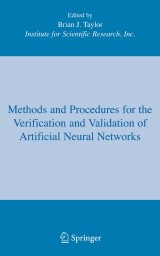Details

Methods and Procedures for the Verification and Validation of Artificial Neural Networks
|
CHF 118.00 |
|
| Verlag: | Springer |
| Format: | |
| Veröffentl.: | 20.03.2006 |
| ISBN/EAN: | 9780387294858 |
| Sprache: | englisch |
| Anzahl Seiten: | 278 |
Dieses eBook enthält ein Wasserzeichen.
Beschreibungen
<P>Neural networks are members of a class of software that have the potential to enable intelligent computational systems capable of simulating characteristics of biological thinking and learning. Currently no standards exist to verify and validate neural network-based systems. NASA Independent Verification and Validation Facility has contracted the Institute for Scientific Research, Inc. to perform research on this topic and develop a comprehensive guide to performing V&V on adaptive systems, with emphasis on neural networks used in safety-critical or mission-critical applications.</P>
<P><STRONG>Methods and Procedures for the Verification and Validation of Artificial Neural Networks</STRONG> is the culmination of the first steps in that research. This volume introduces some of the more promising methods and techniques used for the verification and validation (V&V) of neural networks and adaptive systems. A comprehensive guide to performing V&V on neural network systems, aligned with the IEEE Standard for Software Verification and Validation, will follow this book.</P>
<P><STRONG>Methods and Procedures for the Verification and Validation of Artificial Neural Networks</STRONG> is the culmination of the first steps in that research. This volume introduces some of the more promising methods and techniques used for the verification and validation (V&V) of neural networks and adaptive systems. A comprehensive guide to performing V&V on neural network systems, aligned with the IEEE Standard for Software Verification and Validation, will follow this book.</P>
Background of the Verification and Validation of Neural Networks.- Augmentation of Current Verification and Validation Practices.- Risk and Hazard Analysis for Neural Network Systems.- Validation of Neural Networks Via Taxonomic Evaluation.- Stability Properties of Neural Networks.- Neural Network Verification.- Neural Network Visualization Techniques.- Rule Extraction as a Formal Method.- Automated Test Generation for Testing Neural Network Systems.- Run-Time Assessment of Neural Network Control Systems.
<P>Artificial neural networks are a form of artificial intelligence that have the capability of learning, growing, and adapting with dynamic environments. With the ability to learn and adapt, artificial neural networks introduce new potential solutions and approaches to some of the more challenging problems that the United States faces as it pursues the vision of space exploration and develops other system applications that must change and adapt after deployment.</P>
<P></P>
<P>Neural networks are members of a class of software that have the potential to enable intelligent computational systems capable of simulating characteristics of biological thinking and learning. Currently no standards exist to verify and validate neural network-based systems. NASA Independent Verification and Validation Facility has contracted the Institute for Scientific Research, Inc. to perform research on this topic and develop a comprehensive guide to performing V&V on adaptive systems, with emphasis on neural networks used in safety-critical or mission-critical applications.</P>
<P></P>
<P>Methods and Procedures for the Verification and Validation of Artificial Neural Networks is the culmination of the first steps in that research. This volume introduces some of the more promising methods and techniques used for the verification and validation (V&V) of neural networks and adaptive systems. A comprehensive guide to performing V&V on neural network systems, aligned with the IEEE Standard for Software Verification and Validation, will follow this book. The NASA IV&V and the Institute for Scientific Research, Inc. are working to be at the forefront of software safety and assurance for neural network and adaptive systems. </P>
<P></P>
<P>Methods and Procedures for the Verification and Validation of Artificial Neural Networks is structured for research scientists and V&V practitionersin industry to assure neural network software systems for future NASA missions and other applications. This book is also suitable for graduate-level students in computer science and computer engineering.</P>
<P></P>
<P>Neural networks are members of a class of software that have the potential to enable intelligent computational systems capable of simulating characteristics of biological thinking and learning. Currently no standards exist to verify and validate neural network-based systems. NASA Independent Verification and Validation Facility has contracted the Institute for Scientific Research, Inc. to perform research on this topic and develop a comprehensive guide to performing V&V on adaptive systems, with emphasis on neural networks used in safety-critical or mission-critical applications.</P>
<P></P>
<P>Methods and Procedures for the Verification and Validation of Artificial Neural Networks is the culmination of the first steps in that research. This volume introduces some of the more promising methods and techniques used for the verification and validation (V&V) of neural networks and adaptive systems. A comprehensive guide to performing V&V on neural network systems, aligned with the IEEE Standard for Software Verification and Validation, will follow this book. The NASA IV&V and the Institute for Scientific Research, Inc. are working to be at the forefront of software safety and assurance for neural network and adaptive systems. </P>
<P></P>
<P>Methods and Procedures for the Verification and Validation of Artificial Neural Networks is structured for research scientists and V&V practitionersin industry to assure neural network software systems for future NASA missions and other applications. This book is also suitable for graduate-level students in computer science and computer engineering.</P>
First book based on alternative standards Includes risk and hazard analysis Includes supplementary material: sn.pub/extras


















